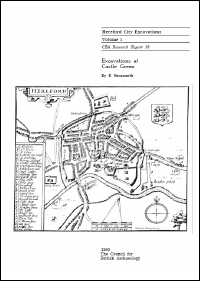CBA Research Reports
Council for British Archaeology, 2000. (updated 2020) https://doi.org/10.5284/1000332. How to cite using this DOI
Data copyright © Council for British Archaeology unless otherwise stated
This work is licensed under the ADS Terms of Use and Access.
Primary contact
Council for British Archaeology
92 Micklegate
York
YO1 6JX
UK
Tel: 01904 671417
Resource identifiers
- ADS Collection: 281
- DOI:https://doi.org/10.5284/1000332
- How to cite using this DOI
Hereford City Excavations - volume 1: Excavations at Castle Green
R Shoesmith
CBA Research Report No 36 (1980)
ISBN 0 906780 05 5
Abstract

Hereford is of great importance in the understanding of the pattern of urban revival after the close of the Roman Empire, because it is one of the best examples in Britain of an early town founded on a virgin site, rather than within the complex ruins of a Roman town or fort. It is also the earliest Saxon town west of the Severn and is apparently one of the earliest examp1es of a post-Roman town laid out on a formal plan. The accepted date for the foundation of the diocese of Hereford is AD 676, but, however important the part played by the Church, the city was pre-eminently a royal foundation with a strategic importance based on its command of the approaches to central Wales and its position astride a recognized ford on the River Wye (Lobel 1969).
This three volume report describes the archaeological work undertaken in the city between 1965 and 1976. The interpretation of the complex series cf defensive works, dating from the mid 9th century, was of primary importance, but the work has also revealed evidence of the internal organization of the city, its roads, houses, and pre-Conquest cemetery.
Contents
- Title pages
- Contents (p v)
- General Introduction (p vi)
- Historical Introduction by D A Whitehead (p 1)
- Previous observations and excavations (pp 6-8)
- The 1973 excavation (pp 8-45)
- Introduction (pp 8-9)
- Acknowledgements (p 9)
- Method (p 9)
- Recording system (p 9)
- Summary of chronology and periods (p 9)
- The excavation (pp 9-24)
- The burial groups (pp 24-30)
- Coffins and coffin fittings (pp 30-39)
- Charcoal associated with burial groups (p 39)
- Radiocarbon dates (p 39)
- The skeletal remains by Justine Bayley (pp 39-45)
- The 1960 excavation - a reassessment (p 45)
- Introduction (p 45)
- Summary of the excavation (p 45)
- Summary of the conclusions (pp 45-47)
- Problems of interpretation in light of the 1973 excavation (p 47)
- The proposed sequence (p 47)
- The burial groups (pp 47-48)
- Dating (p 48)
- Conclusions (p 48)
- The cemetery (pp 48-54)
- The religious establishment (pp 54-56)
- The castle (pp 56-60)
- The landscaping (p 60)
- The site in the future (pp 60-61)
- Bibliography (p 61)
Download report
| Hereford City Excavations - volume 1: Excavations at Castle Green (CBA Research Report 36) | 3 Mb |







